Find more information in the General Comments section of the assessment
Find more information in the Rating Validity tab of the assessment
- See More
- See More
- See More
- See More
- Good
- Adequate
- Marginal
- Weak
- Poor
 Passenger
Passenger
 Driver
Driver
 Rear Passenger
Rear Passenger
 Driver
Driver
 Car
Car
 Pole
Pole
 Rear Seat
Rear Seat
 Front Seat
Front Seat
- Good
- Adequate
- Marginal
- Weak
- Poor


Passenger
outboard
center
Fitted to the vehicle as standard
Not fitted to the test vehicle but available as option
Not Available
-
Infants up to 13 kg
-
Infants and toddlers up to 18 kg
-
Toddlers from 9 to 18 kg
-
Toddlers over 18 kg
Easy
Difficult
Safety critical
Not allowed
| Seat Position | ||||
|---|---|---|---|---|
| Front | 2nd row | |||
| Passenger | Left | center | Right | |
| Maxi Cosi Cabriofix (Belt) | ||||
| Britax Römer King Plus (Belt) | ||||
| Britax Römer Duo Plus (ISOFIX) | ||||
| Britax Römer KidFix (Belt) | ||||
| Maxi Cosi Cabriofix & EasyFix (Belt) | ||||
| Maxi Cosi Cabriofix & EasyFix (ISOFIX) | ||||
| BeSafe iZi Kid X3 ISOfix (ISOFIX) | ||||
| Maxi Cosi Pearl & Familyfix (ISOFIX) | ||||
| Britax Römer KidFix (ISOFIX) | ||||
Easy
Difficult
Safety critical
Not allowed
The Karl scored maximum points for its protection of the 1½ year dummy in the dynamic crash tests. In the frontal offset barrier test, forward movement of the 3 year dummy, sat in a forward-facing restraint, was not excessive although chest and neck decelerations were marginally high. In the side impact barrier test, the 1½ year dummy was properly contained within the shell of its restraint, minimising the likelihood of head contact with parts of the car interior. However, the surface of the 3 year dummy's head was just outside the outer wing of the restraint and scored no points for head containment. The front passenger airbag can be disabled to allow a rearward-facing child restraint to be used in that seating position. Clear information is provided to the driver regarding the status of the airbag and the system was rewarded. All of the child restraint types for which the Karl is designed could be properly installed and accommodated in the car.
- Good
- Adequate
- Marginal
- Weak
- Poor

Head Impact 15.9 Pts
Pelvis Impact 2.6 Pts
Leg Impact 6.0 Pts
The bumper scored maximum points, providing good protection to pedestrians' legs in all areas tested. The protection offered to the pelvic region was far more mixed, some areas performing well and some poorly. The protection provided to the head of a struck pedestrian was predominantly good or adequate on the bonnet surface and on the windscreen, with poor protection observed at the base of the windscreen and on the stiff windscreen pillars.
- Good
- Adequate
- Marginal
- Weak
- Poor
| Speed Limit Information Function | N/A |
| Warning Function | Manually set |
| Speed Limitation Function | Manually set |
| System Name | ESC | |
| Performance | ||
| Vehicle Yaw Rate @ COS + 1.00 s | 1.5% | meets ECE requirements |
| Vehicle Yaw Rate @ COS + 1.75 s | 1.2% | meets ECE requirements |
| Lateral Displacement @ BOS + 1.07 s | 3.1 m | meets ECE requirements |
| Applies To | All seats | ||
| Warning | Driver Seat | Front Passenger(s) | Rear Passenger(s) |
| Visual | |||
| Audible | |||
|
|||
| Type | Lane Departure Warning |
| Operational From | 60 km/h |
| Warning | Audible & Visual |
| Performance | |
|
LDW Confirmation Test
|
Pass |
The Karl has electronic stability control as standard, together with a seatbelt reminder system for the front and rear seats. A driver-set speed limiter is an option, as is a lane departure warning system. The Karl does not have an autonomous emergency braking system.
- Specifications
- Safety Equipment
- Videos
- Rating Validity
Specifications
Tested Model Opel Karl/Vauxhall Viva 1.0 Enjoy, LHD
Body Type - 5 door hatchback
Year Of Publication 2015
Kerb Weight 920kg
VIN From Which Rating Applies - all Opel Karls
Class City and Supermini
Safety Equipment
Note: Other equipment may be available on the vehicle but was not considered in the test year.
Fitted to the vehicle as standard
Fitted to the vehicle as option
Not fitted to the test vehicle but available as option
Not Available
Not Applicable
Videos
Rating Validity


Find more information in the General Comments section of the assessment
 Share
Share
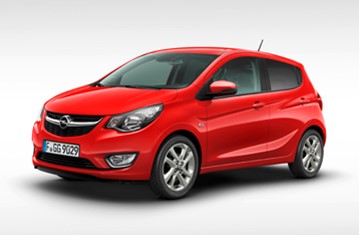

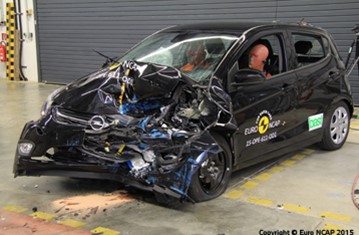



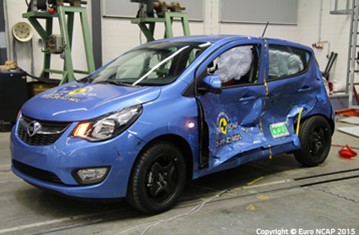
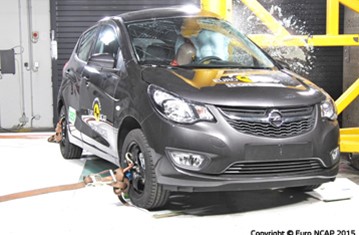
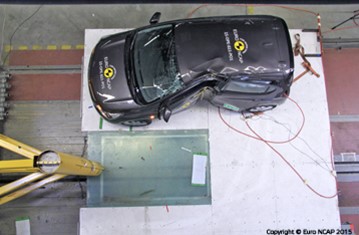



The passenger compartment of the Karl remained stable in the frontal offset test. Examination of the high speed films and of the dummy traces showed that the head of the driver dummy was not stable on the airbag. There was insufficient pressure in the airbag to prevent the head from flattening it and the head made contact, through the deflated bag, with the steering wheel. Thereafter, the head was unstable and rolled off the steering wheel to one side. The score for head protection was penalised and its protection was rated as adequate. Dummy readings in the lower leg indicated marginal protection of this part of the body for the driver. In the full-width rigid barrier frontal impact, the driver's pelvis slid beneath the part of the seatbelt passing over the lap. This is known as 'submarining' and presents risks to the knee, femur and pelvis. The score for this body region was penalised and protection was rated as poor. In the side barrier test, the Karl scored maximum points with good protection of all body regions. However, in the more severe side pole test, dummy readings showed very high rib deflections and protection of the chest was rated as poor, indicating a high risk of serious injury. Opel intend to make improvements to the chest protection in side impacts. The front seats and head restraints showed a marginal level of protection against whiplash injury in the event of the rear-end collision. A geometric assessment of the rear seats indicated the same level of whiplash protection for the rear seat occupants. Autonomous emergency braking is not available on the Karl.